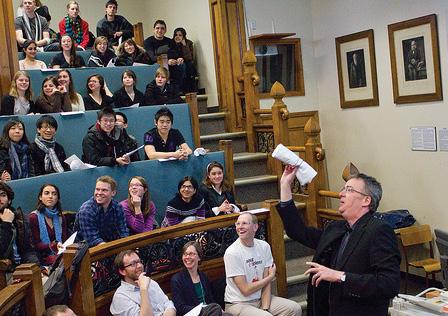
5 minute read
McGill researchers give rapid-fire presentations at 35th edition of Soup and Science
Ali Baghirov, Atticus O’Rourke Rusin Staff Writers
Russel Ismael, Ella Paulin Science & Technology Editors
Advertisement
The 35th semesterly Soup & Science was one for the books, with top-notch student and professor research presentations accompanied by delectable soup. The McGill Tribune brings you the presentations we liked best for a little taste of the event.


Improving mRNA resilience by combining it with other molecules
U4 chemistry student Sally Yao presented her research about the instability of nucleic acidss, which are the gene-storing molecules that form DNA and RNA.
“From COVID, many of us are familiar with therapeutic nucleic acids, which are mRNA vaccines,” Yao explained. “Despite its great efficacy in treating diseases […] the biggest limitation is that it’s really unstable under ambient temperature.”
Because mRNA vaccines cannot be stored above a temperature of 20 degrees Celsius, communities in hot or remote areas have limited access to them. The same instability causes mRNA from COVID-19 vaccines to degrade in our bodies over time, meaning that we may have to take more booster shots, exhausting our immune systems.
Yao’s research endeavours to bind nucleic acids to poly-A, a chain of nucleotides in mRNA, to form a three-stranded molecule that our cells cannot degrade. Perfecting this will solve the myriad issues of mRNA vaccine storage, like temperature and expiration dates.
Sustainably processing shellfish waste
Chemistry professor Audrey Moores presented her research on finding ways to sustainably process discarded shells from the shellfish industry.
“If I look at the province of Quebec, we estimate that we generated about 14,000 tons of the [shellfish] waste every year, which is humongous. And right now, we don’t do anything with that waste,” Moores said. “This is a missed opportunity because these materials can actually give rise to value-added materials.”
Moores’ research could lead to a sustainable, practical way to handle shellfish that would help limit the environmental impact of leaving huge piles of shells along shores. It would also allow us to make use of the valuable components present in shells.
“They contain nitrogen-containing molecules, which is very rare for stuff coming from nature,” said Moores. “This can be interesting because it has some cool applications in the biomedical area, for instance.”
How do experiences of racism impact longterm health?
Darius Scott, an assistant professor in the Department of Geography, spoke about his work mapping the relationship between health outcomes and people’s experiences of stigmatization and racism, as well as their perceptions of how accepting their environment is.
“In thinking about stigma and health, again, there’s so many factors or so many outcomes that are associated with stigma,” Scott said. “I’m just starting here in Montreal, seeking out Black, gender, and social minority adults, and the impacts of past and recent stigmatizing experiences on their perceptions of the city.”
In the past, he has conducted studies asking similar questions in the American South, making discoveries that inform and motivate his research here in Montreal. Some findings indicated that experiences of stigmatization can have long-lasting effects on how individuals, Black gay men in particular, felt about their communities.
“The folks I was working with suggested that even if you live in an environment that’s more accepting, past experiences of stigma can be so persistent in dictating your perception of your present-day environment,” Scott said.
Stable isotope biogeochemistry and paleoclimatology
Associate professor Peter Douglas’ research focuses on the role of methane emissions in global warming, both in wild environments, such as natural landscapes in northern Quebec, and populated towns.
Methane is a focus of climate change research because it warms the atmosphere 32 times faster than carbon dioxide (CO2).
“While there is a lot more CO2, methane has a very big impact on the atmosphere—it accounts for about 25 per cent of anthropogenic global warming,” Douglas said during his presentation.
Large amounts of carbon are stored in permafrost—permanently frozen soil that is common in Canada.
“We’re worried that as the planet warms, this is going to release carbon [from permafrost] in the environment and it is going to turn into CO2 and methane,” Douglas added.
His team found, using radioactive carbon isotope dating, that methane in the environment is actually derived from “younger” carbon compared to other carbon-based emissions. This is because “almost all [methane] is coming from human operations, with some coming from tailings ponds and some from bitumen mining.”
Community relationships to governmental conservation efforts
Associate professor of geography Brian Robinson’s research focuses on the way communities use the environment to implement conservation efforts that target highly exploited areas.
Robinson’s research specifically looks at how communities in China interact with the environment. His data found that low-socioeconomic status communities were more likely to depend on their natural surroundings for their livelihoods.
Another focus is how governmental policies and institutions affect the environment, focusing on agricultural subsidies. China passed legislation to compensate herders who limited their livestock numbers in an attempt to preserve regional grasslands. Robinson studied this policy to determine the size of its ecological impact.
He found that payments were insufficient to cover the losses that herders incurred as a result of downsizing their livestock and that the Chinese government would need to increase their payments in order to see larger benefits from the program.
Randomness in infinite dimensions
Mathematics professor Linan Chen studies what comprises “randomness” through probability regarding concepts with “infinite dimension.”
“We can think of dimension as a degree of freedom,” Chen said. “A line only has one degree of freedom, while a plane has two dimensions, so you have two degrees of freedom [...] we’re going to see infinite dimensional randomness—all of them related to geometry.”
Chen explained that you would need to “put an infinite degree of randomness” to get a truly random curve.
“In fact, nature has given us the best answer,” Chen said. “Robert Brown was a botanist who put [...] pollen on top of water’s surface, and as the water molecules kick and bounce off, the pollen moves across the water’s surface, leaving a [zig-zag-like route.]”
Brownian motion can be found in water molecules diffusing through a cell membrane, and it’s different from other curves like a sine wave because there are infinite degrees of randomness found within Brownian curves.



Links between vitamin D and autoimmunity
Physiology professor John White presented his research about how vitamin D deficiency in childhood affects autoimmunity later in life, discerning that it can lead to Type 1 diabetes or multiple sclerosis.
“The clinical evidence suggests that vitamin D is influencing the process in the thymus called negative T-cell selection, in which Tcells of the immune system that recognize the ‘self’—anything that you produce, [and] for the most part, proteins—as a foreign invader, [rendering them] immunologically innocuous,” White said.
Autoimmune regulators (AIREs) are proteins that drive gene transcription for every protein encoded in your thymus. Vitamin D’s role in the thymus was unknown until White discovered it’s a cofactor with AIREs, as it assists AIREs in chemical reactions.
“Vitamin D stimulates the transcription of a number of genes that are regulated by AIRE,” White said. “This puts vitamin D at the heart of the critical transcriptional events that are necessary to control negative T-cell selection.”
Evaluating aptamers as DNA repair inhibitors
U3 pharmacology student Antoine Moitessier’s research involves using aptamers— DNA or RNA strands that can fold into a threedimensional structure and bind to target molecules, such as proteins—as cancer-preventing agents.
Moitessier seeks to understand how current therapeutic methods for cancer, like chemotherapy, involve DNA denaturation and also take a large toll on patients’ overall health.
“[DNA denaturation] is toxic to cells, [so] the idea is that they will also be toxic to cancer cells as well, but they, of course, have many side effects,” Moitessier explained.
Aptamers should inhibit DNA polymerase beta from repairing damaged cells with cancerous cells, preventing the cancer’s growth. Moitessier focused on aptamers because of their high affinity, which means they bind ‘tightly’ to targets, and high specificity, since they attach to only a certain cell type. As opposed to chemotherapy, aptamers will not cause cell death.









